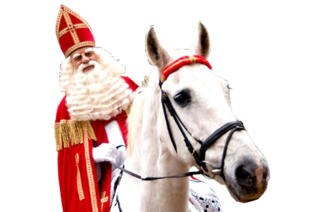
Sinterklaas or Sint-Nicolaas is the main figure in the yearly feast that's celebrated in The Netherlands, Belgium and in several (former) Dutch Colonies. The Netherlands celebrates Sinterklaas on December 5th, Belgium on December 6th.
Origin
The origin of Sinterklaas predates Christianity, there are simularities between his legend and the figure of Odin - a Germanic god. As Christianity grew in Europe they've added many pagan customs and holidays to their own. Sinterklaas rides a white horse over the rooftops, gives chocolate letters to children and carries a staff. Odin rides a grey horse in the sky, gave rune letters to man and has a spear. One other similarity is the mischievous helpers, Odin has two black ravens called Huginn and Muninn who tell Odin all that is going on in his realm, Sinterklaas has human helpers with black faces. They too report back to him and let him know if children have been good or bad.
Sinterklaas is known under many names like Sint Nicolaas, Goedheiligman, de Goede Sint and de Sint to name but a few Dutch ones. The way that the traditional festivities are celebrated now mostly come forth from a book that was written in 1850 called 'Sint Nicolaas en zijn knecht' (English: Saint Nickolaas and his helper) by teacher Jan Schenkman.
Sinterklaas is typically celebrated on the evening of the 5th of December and in Belgium, Northern-France and Luxemburg on the morning of the 6th of December. In the French parts he's known as Saint-Nicolas and in Luxemburg as Kleeschen and Zinniklos.
His birthday was celebrated on the 6th of December throughout the middle ages. It was a feast to celebrate the name day of Saint Nicholas who lived from 270-343. He was the patron saint of Children. Part of Saint Nicholas' remains were taken from, what is now known as, Turkey and brought to Bari in southeastern Italy. Bari later formed part of the Spanish Kingdom of Naples and remained a part of Spain until the 18th century. From this fact stems the belief that Sinterklaas lives in Spain and only comes over for the festivities. His black helpers also come from Spain and are known as Zwarte Piet (English: Black Pete(s)). Saint Nicolas was the patron saint of Sailors, named so for all the help he gave the sailors in his home town, this is why he comes to the Netherlands on a Steamboat. He shows kindness to children and gives them gifts.
Zwarte Pieten (Black Pete)

Sinterklaas is assisted by many mischievous helpers with black faces and colorful Moorish dresses. Although the character of Black Pete is now most known for racial connotations, his origins were in the evil figure. Good and bad play an important role in the feast: good is rewarded, bad and evil are punished. Bad children are believed to be taken in the Black Pete's bag and taken back to Spain on the steamboat, where they will be put to work and beaten with twigs.
Other facts
Many Dutch and Belgian artists and writers write Sinterklaas and/or his helpers into stories of their own characters. They are usually short and meant to be funny.
The American Santa Claus was partly based on Sinterklaas
Log in to comment